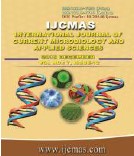


 National Academy of Agricultural Sciences (NAAS)
National Academy of Agricultural Sciences (NAAS)

|
PRINT ISSN : 2319-7692
Online ISSN : 2319-7706 Issues : 12 per year Publisher : Excellent Publishers Email : editorijcmas@gmail.com / submit@ijcmas.com Editor-in-chief: Dr.M.Prakash Index Copernicus ICV 2018: 95.39 NAAS RATING 2020: 5.38 |
Globally, banana is the maximum distributed fruit crop and is the fourth most important commodity and is grown in more than 130 countries across the world, continuously exhibiting a spectacular growth pattern worldwide in an area of 6507.7 million ha producing 98946 million tones. India is the largest producer of banana in the world. There are diverse germplasms of banana traditionally cultivated in different regions of India having remarkable genetic differences. Traditional procedure to characterize banana plants by morphological descriptors has many limitations. Different communities refer to the local cultivars by different names and lack of clear clone identity in the crop has resulted in unnecessary duplication with regard to cultivation, conservation and research. To alleviate this problem application of modern finger printing technology through DNA studies have been recommended for accurate selection of banana clones. Randomly Amplified Polymorphic DNA (RAPD) markers are usually preferred for the initiation of this kind of work as the technique is simple, versatile, relatively inexpensive and able to detect minute differences. Progress in the breeding of plantain and banana has been restricted by the complex genetic structure and behavior of cultivated polyploidy Musa. Genetic improvement has been hindered due to the large amount of space required for growth and maintenance of plant populations, in addition to the long growth cycle and the low levels of fertility and seed viability characteristic of cultivated genotypes. Molecular marker assisted breeding has the potential to dramatically enhance the pace and efficiency of genetic improvement in Musa. A proper classification of Musa clones and cultivars is important to assisting the selection of characters for banana breeding. In the present investigation, a detailed study was performed to evaluate the characterization of banana genotypes done by genetical assessment through RAPD markers. For this study, fifteen genotypes were used. By analyzing the molecular characters, we found several clusters and for the conformation of their genetical stability. Evaluating molecular characters of clusters we observed genetical assistance proved that eleven cultivars were fully characterize and they prevailed in same group (ABB group) except Manjeri Nendran and Nendran (AAB).
 |
 |
 |
 |
 |